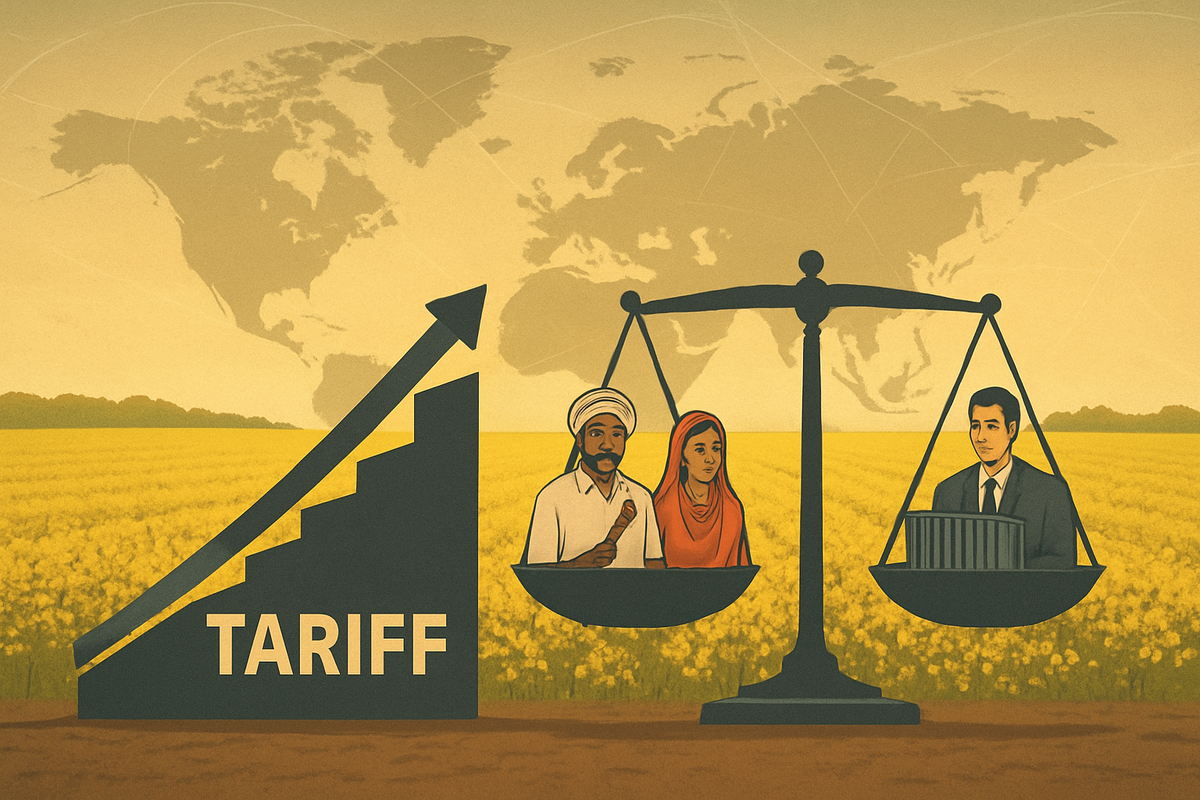
India, a colossal player in the global agricultural landscape, has once again sent ripples through international commodity markets with the sudden re-imposition of a 30% import duty on yellow peas. Effective November 1, 2025, this decisive move reverses a temporary policy that had allowed duty-free imports until March 31, 2026. Announced late on October 29 or 30, 2025, the decision aims to staunch the flow of inexpensive foreign yellow peas, bolster domestic pulse prices, and provide crucial support to Indian farmers ahead of the critical rabi-sowing season.
The immediate implications have been swift and significant. Domestic yellow pea prices in Indian mandis (wholesale markets) surged by ₹150-325 per quintal, pushing prices from approximately ₹3,500 to around ₹3,800 per quintal. This price correction extended to other pulses like chana (chickpea) and masur (lentil), which also saw price increases, signaling a broader market recalibration. Internationally, major yellow pea exporters such as Canada and Russia expressed disappointment, bracing for reduced demand and potential downward pressure on global prices.
A Strategic Pivot: Protecting Domestic Agriculture
The re-imposition of the 30% import duty on yellow peas by the Indian government marks a significant policy shift, aimed squarely at recalibrating the domestic agricultural market. The decision, effective November 1, 2025, with an exemption for shipments with a bill of lading dated on or before October 31, 2025, was a direct response to a glut of cheap imports that had depressed local pulse prices. For months leading up to this decision, domestic varieties such as chana, tur, urad, masoor, and moong were trading below their respective Minimum Support Prices (MSPs), largely due to the overwhelming supply of inexpensive yellow peas from key exporting nations like Canada and Russia.
The timeline leading to this moment saw a period of duty-free imports, initially intended to manage food inflation and ensure adequate supply. However, the unchecked inflow created an imbalance, hurting the livelihoods of millions of Indian farmers. The Indian Ministry of Agriculture and Farmers' Welfare, alongside the Ministry of Commerce, were key stakeholders in this decision, responding to persistent calls from farmer associations and agricultural lobbies to protect domestic producers. The announcement itself, coming late in October 2025, provided a narrow window for importers to clear existing shipments, adding to the immediate market volatility.
Initial market reactions were a mix of relief for domestic producers and concern for importers and international suppliers. The landed price for new shipments of yellow peas in India is projected to increase by nearly ₹9 per kg, fundamentally altering the economics for traders. While domestic chana and tur prices saw moderate increases of ₹50-100 and ₹25-50 per quintal respectively, the most pronounced impact was on yellow peas and masur, which jumped by around ₹100 per quintal. This indicates a rapid adjustment by the market to the new cost structure, with a clear signal that the era of ultra-cheap yellow pea imports is, for now, over.
Companies Navigating the New Tariff Landscape
The re-imposition of India's 30% import duty on yellow peas will undoubtedly create a distinct set of winners and losers across the global agricultural supply chain. Domestically, Indian farmers cultivating pulses like chana, tur, and masur are poised to be major beneficiaries. With the price floor for yellow peas now significantly higher, the competitive pressure on these alternative pulses will ease, allowing their prices to firm up closer to or above MSPs. This could translate into improved profitability and greater stability for millions of small and marginal farmers across India.
Conversely, major international agricultural commodity trading houses and exporters, particularly those based in Canada and Russia, face considerable headwinds. Companies like Viterra (privately held, but a major player in Canadian agriculture) and Richardson International (privately held) in Canada, along with Russian grain exporters, who have historically supplied significant volumes of yellow peas to India, will likely see a substantial reduction in demand from what was once a lucrative market. Their export strategies will need immediate recalibration, potentially diverting volumes to other markets or adjusting their procurement from farmers. This could lead to lower farmgate prices for yellow peas in these exporting countries, impacting their own domestic agricultural sectors.
Indian importers and processors who rely heavily on inexpensive yellow peas as a raw material will experience increased input costs. Food processing companies that use yellow peas for various products, or wholesale distributors, will either have to absorb these higher costs, pass them on to consumers, or seek alternative domestic pulse varieties. This could potentially affect the profit margins of publicly traded Indian food companies, though specific impacts would depend on their raw material sourcing flexibility and market pricing power. The shift may also spur greater investment in domestic pulse processing infrastructure within India, as local sourcing becomes more economically viable.
Broader Implications: Trade, Trends, and Precedents
India's decision to impose a 30% import duty on yellow peas is not an isolated event but rather a significant move within a broader global trend of nations prioritizing domestic food security and farmer welfare. This action fits into a larger pattern where governments are increasingly willing to use trade policy tools, such as tariffs, to manage internal agricultural markets and protect local industries from import surges. The move underscores India's strategic intent to reduce reliance on imported pulses, a critical dietary staple for its vast population, and achieve greater self-sufficiency in its food basket.
The ripple effects of this policy are expected to extend far beyond the immediate yellow pea market. Competitors in the global pulse trade, such as Australia and the United States, which also export various pulses, may see shifts in demand patterns as India's import needs for other pulses adjust. For instance, if Indian processors pivot from yellow peas to domestically grown chana or masur, it could indirectly affect the global supply-demand balance for those specific pulses. Furthermore, the decision could strain trade relations with major exporting nations like Canada and Russia, potentially leading to discussions or even retaliatory measures in other agricultural or trade sectors, although such escalation is not immediately anticipated.
Historically, India has a precedent of using import duties to manage its pulse markets. In 2017-2018, similar duties were imposed on various pulses, including yellow peas, to curb excessive imports and support domestic prices. These past interventions have often led to temporary market disruptions, followed by a re-balancing as global suppliers adjust their strategies and domestic production responds. The current action, therefore, is consistent with India's past policy toolkit, signaling a predictable response to similar market conditions. It highlights the inherent volatility in agricultural commodity trade when a major consumer market like India adjusts its import policies.
The Road Ahead: Market Adaptations and Strategic Shifts
The re-imposition of the 30% import duty on yellow peas sets the stage for a dynamic period of adaptation and strategic realignment in both domestic and international agricultural markets. In the short term, Indian consumers may experience a slight increase in the retail prices of yellow peas and derived products, as the higher import costs are gradually passed on. However, this is expected to be balanced by the positive impact on domestic pulse farmers, who will likely see improved profitability and potentially increased acreage for pulse cultivation in the upcoming seasons, responding to better price signals.
Longer term, this policy could catalyze significant shifts in India's agricultural supply chain. It may encourage greater investment in domestic pulse production, storage, and processing infrastructure, aiming to reduce future reliance on imports. For international exporters, the challenge lies in diversifying their markets and finding alternative destinations for their yellow pea surpluses. This could lead to increased competition and potentially lower prices in other yellow pea-consuming regions globally, as Canadian, Russian, and Ukrainian exporters seek new buyers. Strategic pivots might include exploring new product applications for yellow peas or focusing on other pulse varieties where demand remains strong.
Market opportunities may emerge for domestic Indian seed companies and agricultural technology providers, as farmers look to optimize yields and efficiency in response to more favorable prices. Conversely, challenges will persist for international traders who had built significant supply chains around India's import demand. Potential scenarios include a sustained period of higher domestic pulse prices in India, a gradual increase in domestic production, and a re-configuration of global yellow pea trade flows. Investors should monitor sowing patterns in India, global yellow pea production forecasts, and any further policy announcements from the Indian government regarding agricultural trade.
Navigating the New Pulse Paradigm
India's decision to re-impose a 30% import duty on yellow peas is a pivotal moment for global agricultural commodity markets, underscoring the delicate balance between consumer affordability, farmer welfare, and international trade dynamics. The immediate surge in domestic yellow pea and other pulse prices in India signals a rapid market adjustment, offering a lifeline to local farmers who had been struggling with depressed prices due to a glut of cheap imports. This move reaffirms India's commitment to bolstering its agricultural self-sufficiency and protecting its vast farming community.
Moving forward, the market will be characterized by increased domestic focus within India and a strategic re-evaluation by international exporters. While Canadian and Russian yellow pea suppliers face the immediate challenge of reduced access to a key market, the long-term outlook for India suggests a more robust and self-reliant pulse sector. This policy is a clear indicator of India's willingness to leverage trade instruments to achieve its national agricultural objectives, a trend that financial market participants in agricultural commodities must closely monitor.
Investors should watch for sustained trends in domestic pulse production in India, any shifts in global yellow pea trade routes, and the potential for new trade agreements or retaliatory measures from affected exporting nations. The lasting impact of this decision will be felt across the agricultural value chain, from seed producers to food processors, shaping market dynamics for years to come. The yellow pea duty serves as a powerful reminder that government policy remains a critical variable in the volatile world of commodity markets.
This content is intended for informational purposes only and is not financial advice





